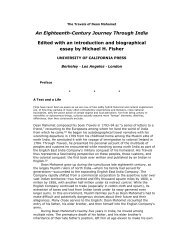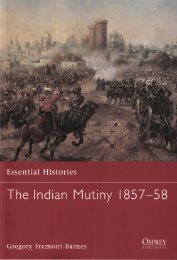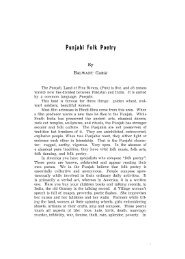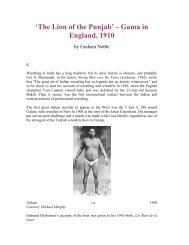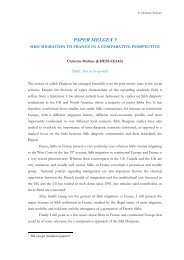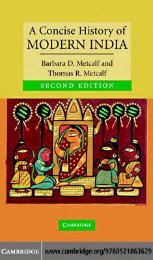- Page 1 and 2:
:: THE LEGENDS OF THE PANJAB. BY CA
- Page 3:
— CONTENTS OF VOLUME I. PAGE I. T
- Page 6 and 7:
VI PREFACE. the folktale are constr
- Page 8 and 9:
) Tin PEEFACE. There are several ki
- Page 10 and 11:
X PEEFAOE, for payment, but, many a
- Page 12 and 13:
2ii PEBFACB. entitled to be express
- Page 14 and 15:
xiv PREFACE, him tlie way out of hi
- Page 16 and 17:
: XVI PEEFACB. become. She compasse
- Page 18 and 19:
XVin PEBFACE. it peeps out only as
- Page 20 and 21:
XX PREFACE. actors simply fly throu
- Page 22 and 23:
SXU PREFACE. in the public choice o
- Page 24 and 25:
— Xxi\r PEEPAOE. time miscellaneo
- Page 26 and 27:
XXVI PEBPACE. ttese are the only in
- Page 29 and 30:
THE LEGENDS OF THE PANJAB. No. I. T
- Page 31 and 32:
—— — EAJA EASALU. 6 her about
- Page 33 and 34:
— — : : eajI easali). 5 And the
- Page 35 and 36:
! — — — EAJA BASALU. 7 his ir
- Page 37 and 38:
sadd — — BAJA BASALT^. 9 " I ha
- Page 39 and 40:
— EAJA EASAlt. 11 So the EajSk to
- Page 41 and 42:
— eajA easalt), 13 Wten the serpe
- Page 43 and 44:
— —— — EAJA EASALt. 15 but
- Page 45 and 46:
—— — : : ! Raja TtASALiy. 17
- Page 47 and 48:
— : — EAJA RASALT)'. 19 Our fat
- Page 49 and 50:
— — — eajA rasal^. 21 told he
- Page 51 and 52:
: ; — eaJa uasalO. 23 '' I did no
- Page 53 and 54:
— BAJA EASAHl). 25 " Spare my lif
- Page 55 and 56:
— : — EAJi EASALfr. 27 teard th
- Page 57 and 58:
The —— " " Open the door at onc
- Page 59 and 60:
—— RAJA KASAL&. 31 II&J3, Prese
- Page 61 and 62:
: — —: ; eM basaliJ. 33 Answere
- Page 63 and 64:
— RAJA RASALt. 35 " bountiful Lor
- Page 65 and 66:
— — — : EAJA EASALU. 37 But t
- Page 67 and 68:
BAJA EASALIJ. 39 " I gave this ring
- Page 69 and 70:
— — EAJA RASALU. 41 Jbe'sure to
- Page 71 and 72:
— — ! : RAJA BASALU. 43 Eight f
- Page 73 and 74:
eM EASALt. 45 Princess, thou hast b
- Page 75 and 76:
— eAjA easAl^. 47 Then the hedgeh
- Page 77 and 78:
— — EAJA EASAL&. 49 to take him
- Page 79 and 80:
— EAJA EASAL^. 51 "Wtat is it tha
- Page 81 and 82:
— EAJl basalt), 53 Said the Edja
- Page 83 and 84:
: — — : : HaJa easalu. 55 Liste
- Page 85 and 86:
: : : — — : RAJA easalt). 57 Sa
- Page 87 and 88:
! — ! EAJA EASALI^. 59 Who fclire
- Page 89 and 90:
— RAJA EASALtJ. 61 Saying this he
- Page 91 and 92:
— : : ; ' BAJA RASAlO. 68 Thy spu
- Page 93 and 94:
— : EAJA EASaLU. C5 Then the Raja
- Page 95 and 96:
: :; ;; Sikhaii sevak^n bania nata,
- Page 97 and 98:
; SAKHi SARWAR AND DANI JATTI. 69 J
- Page 99 and 100:
! ; ; : SAKHl SAEWAE AND DANI JATTi
- Page 101 and 102:
! ! " 163 Tiln mawan puttar milaia
- Page 103 and 104:
! ! ; : : SAKHi 3AEWAR AND DANI JAT
- Page 105 and 106:
; SAKE SAEWAE. AND DANI JATt!. 'i7
- Page 107 and 108:
: ; ; ! : : : sake! SARWAR and DANI
- Page 109 and 110:
:;! ! " SAKHi SAEWAE AND DANI JATTI
- Page 111 and 112:
; " : ; DHANNA, THE BHAGAT. 15 Bar&
- Page 113 and 114:
; :; ; : ; : ; ; DHANNA, THE BHAGAT
- Page 115 and 116:
: !; : : : DHANNA, THE BHAGAT. 87 H
- Page 117 and 118:
; ; : ; ; VIII, Saith the Bi'&hman,
- Page 119 and 120:
: ; ! : : ; No. IV. THREE FRAGMENTS
- Page 121 and 122:
Kakki : : : ; THREE PRAGMKNTS ABOUT
- Page 123 and 124:
§ "; :; ! THREE FRAGMENTS ABOUT SA
- Page 125 and 126:
THREE FRAGMENTS ABOUT SAEWAE. ^7 As
- Page 127 and 128:
: ! : ; ; THE MARRIAGE OP GHAZl SAL
- Page 129 and 130:
; THE MAREIAGB OF GHAZl SALAR. 101
- Page 131 and 132:
! " THE MARRIAGE OF GHAZl SAI.AB. 1
- Page 133 and 134:
: : : ; : THE MAREUOE Off GhAzI SAL
- Page 135 and 136:
! : ;: ! ! : ! : THE SIARBIAGE OF G
- Page 137 and 138:
; THE MARRIAGE OP QHAZI SAbAR. 109
- Page 139 and 140:
t : THE MAEEIAOE OF GHAZi SALAE. Il
- Page 141 and 142:
; : " THE MAREIAGE OF GHAZ! SALAB.
- Page 143 and 144:
; " ! THE MABRIAQE 01' GhAzi SALAR.
- Page 145 and 146:
; ! : " ; ; THE MAEBIAGE OF GHAZI S
- Page 147 and 148:
; " come on Raja ! " Where are you
- Page 149 and 150:
No. THE LEGEND OF VI. GURU GUGGA, A
- Page 151 and 152:
! ! THE LEGEND OP GUEU GUGGA. 123 N
- Page 153 and 154:
: THE LEGEND OP GUBU GUGGA. 125 Edn
- Page 155 and 156:
• Jo ; THE LEGEND OF GUKU GUGGA.
- Page 157 and 158:
: ! THE LEGEND OF GURU GTJGGA. 129
- Page 159 and 160:
THE LEGEND OP GURU GUQGA. 131 M lad
- Page 161 and 162:
! THE LEGEND OE GDEU GUGGA. 133 Gur
- Page 163 and 164:
: ; !: THE LEGEND OP GDEXJ GUGGA. 1
- Page 165 and 166:
; ; THE LEGEND OF GURD GUGGA. 137 "
- Page 167 and 168:
: ! THE LEGEND OF GUH^ GUGfiA. 139
- Page 169 and 170:
THE LEGEND OF GURU GUflGA. 141 Ouru
- Page 171 and 172:
! ! ! THE LEGEND OF UURU GUQGA. 143
- Page 173 and 174:
! ! THE LEGEND OP GURU OOGGA. 145 S
- Page 175 and 176:
THE LEGEND OF GURU GUOGA. 147 Raja
- Page 177 and 178:
" Tell me the truth. Thou art my Go
- Page 179 and 180:
" ": THE LEGEND OF GURU GUGGa. 151
- Page 181 and 182:
utar ; ! THE LEGEND OF GUEU GUGGA.
- Page 183 and 184:
THE LEGEND OP GURU GUGOA. 1'5& Bare
- Page 185 and 186:
! ! " 400 NaLin bS,lak paidS. hua,
- Page 187 and 188:
' " cavalcade.'' thine honor ! THE
- Page 189 and 190:
t "THE LEGEND OP OUufj GUGGA. 161 4
- Page 191 and 192:
: THE LEGEND OF GURU GUGGA. 163 Kal
- Page 193 and 194:
make THE LEGEND OP GURU GUGGA. 165
- Page 195 and 196:
; TH^ LEGEND OP GVUts GUGGA. 167 Sr
- Page 197 and 198:
! : THE LEGEND OF GURU GDGGA. 169 L
- Page 199 and 200:
5C5 ! ! THE LEGEND OP GUEU ODGGA. 1
- Page 201 and 202:
! ! ! THE LEGEND OP GURU GUGOA. 173
- Page 203 and 204:
: : : ! : THE LEGEND OF GUEU GUGGA.
- Page 205 and 206:
! ! ' " * Ky4 biptd tum par pari m
- Page 207 and 208:
" THE LEGEND OP GURU GI/GQA. 17^ Ta
- Page 209 and 210:
THE LEGEND OP GURU GUGGA. 181 Mukh
- Page 211 and 212:
: ; ; ; TH]g LEGEND OF GUEU GUGGA.
- Page 213 and 214:
THE LEGEND OF GURU GUGGA. 185 Tatig
- Page 215 and 216:
THE LEGEND OF GURU GUGGA. 187 : Tat
- Page 217 and 218:
: THE LEGEND OF OUR& GDQGA. 189 H^t
- Page 219 and 220: : my ! THE LEGEND OF GOEU GUGGA. 19
- Page 221 and 222: : ! : THE LEGEND OF GUfiU QUGGA. 19
- Page 223 and 224: ! ! " THE LEGEND OF GUBU GUGGA. 195
- Page 225 and 226: ! : : THE LEGEND OF GURU GUGGA. 197
- Page 227 and 228: ! : THE LEGEND OF GURU GUGGA. 199 S
- Page 229 and 230: ; ! ! ! THE LEGEND OF GURU GUGGA. 2
- Page 231 and 232: : ! ! THE LEGEND OF GUKU GUGGA. 203
- Page 233 and 234: " ; HindA chale masdn, re Beta, tuj
- Page 235 and 236: THE LEGEND OF GURU GUGOA. 20i 980 R
- Page 237 and 238: THE LEGEND OF GUR^ GUGGA. 209 1005
- Page 239 and 240: :: ; : ; ! " Bhai, maiii nun kalle
- Page 241 and 242: " ; ! ;! " THE BALLAD OF iSA BANIYA
- Page 243 and 244: : ; ; ; ; THE BALLAD OF ISA BANIYA.
- Page 245 and 246: :; : THE BALLAD OF ISA BAPARf. 217
- Page 247 and 248: THE BALLAD OF ISA BAPARL 219 Lalan
- Page 249 and 250: ; ; ; THE BALLAP OF ISA BAPARl. 221
- Page 251 and 252: THE BALLAD OF ISA BAPAR!. 223 95 Sp
- Page 253 and 254: : No. IX. the Panjabi Legends which
- Page 255 and 256: : :; : : PRINCESS ADHIK ANI^P DaI.
- Page 257 and 258: : :: : " " Itni sun totS, kahe, " S
- Page 259 and 260: ! : : : : : PRINCESS ADHIK ANOP DAf
- Page 261 and 262: ; PRINCESS ADHIK ANUP DAI. 233 EasS
- Page 263 and 264: ! : PRINCESS 'adhik anup da!. 235 T
- Page 265 and 266: ; . PRIKCESS ADEIK ANUP DAI. 237 95
- Page 267 and 268: : PRINCESS ADHIE ANUP DAI. 239 Brin
- Page 269: : : : : : ; ; PRINCESS ADHIK ANUP D
- Page 273 and 274: : THE LEGEND OF sIlA DAf. 245 The t
- Page 275 and 276: ! ": " Satwanti hai n§.rj meri gha
- Page 277 and 278: " THE LEGEND OF SILA DAt. 249 Jo gh
- Page 279 and 280: : : ; : ; THE LEGEND OF ^Ila DAL 25
- Page 281 and 282: THE LEGEND OP SiLA DA!. 263 Slid Bd
- Page 283 and 284: THE LEGEND OF bJLA DAI. 255 Lefeha
- Page 285 and 286: : THE LEGEND 0¥ sIlA DAL 257 145 C
- Page 287 and 288: ! ! " THE LEGEND OE SILA DAI. 259 J
- Page 289 and 290: THE LEGEND OF sfLA DAi 261 Turn kal
- Page 291 and 292: THE LEGEND OP sIla DA!, 263 " RdjcL
- Page 293 and 294: : ! " Tere binei, main na karun bha
- Page 295 and 296: ; : THB^ LEGEND OP SthA. DAI 2'67 T
- Page 297 and 298: : : THE LEGEND OF sSlA DAI. 269 Ult
- Page 299 and 300: ; : ; : THE LEGEND OF s!lA DA!. 271
- Page 301 and 302: : : THE LEGEND OF sJla DAt. 273 Aur
- Page 303 and 304: : ! THE LEGEND OF slhl DA2. 275 Kya
- Page 305 and 306: : " Jin ghar ' ho na baithna/ oh ka
- Page 307 and 308: : : " THE LEGEND OP sIla DaI. 279 R
- Page 309 and 310: : ! THE LEGEND OP sIlA DaJ. 281 Tol
- Page 311 and 312: : THE LEGEND OP SflA DAf. 283 Ave s
- Page 313 and 314: THE LEGEND OF Sthk DAI. 285 In dos
- Page 315 and 316: '! ; THE LEGEND OP siLA DAI. 287 Pa
- Page 317 and 318: : ! THE LEGEND OF stLA DAI. 289 *'
- Page 319 and 320: : ; ! THE LEGEND OF sIlA DA!. 291 T
- Page 321 and 322:
: : : THE LEGEND OF SilA DAt. 293 A
- Page 323 and 324:
: :! : !; ' : 640 K&ghaz, qalam, da
- Page 325 and 326:
; ! THE LEGEND OF sfLA DAi. 297 Eya
- Page 327 and 328:
: : THE LEGEND OP sIla DAt. 299 Tis
- Page 329 and 330:
: , THE LEGEND OP SILA DAL 301 Tarn
- Page 331 and 332:
: : THE LEGEND OF sIlI DAt. 303 Un
- Page 333 and 334:
: : ; ; 'THE LEGEND OF SILA DAL 305
- Page 335 and 336:
; : ; THE LEGEND OP SILA DAf. 307 R
- Page 337 and 338:
;" : : THE LEGEND OF sIla DAf. 309
- Page 339 and 340:
; THE LEGEND 01' sfLA DAI. 311 845
- Page 341 and 342:
. " It is the will of God which way
- Page 343 and 344:
: THE LEGEND OF sIla DA!. 315 Mahit
- Page 345 and 346:
THE LEGEND OF s!la DAt. 317 Sab p^p
- Page 347 and 348:
: ! THE LEGEND OE SILA PAi. 319 Nah
- Page 349 and 350:
" : : THE LEGEND OF SILA DAf. 321 N
- Page 351 and 352:
! " : ! !; all virtue and beauty !
- Page 353 and 354:
THE LEGEND OP sIla DAL 325 Ragni. 1
- Page 355 and 356:
! ! ; " . 1040 Show me the way of s
- Page 357 and 358:
THE LEGEND OF sIla DAf. 329 Tan tri
- Page 359 and 360:
! : ! ! THE LEGEND OP StLA DAi. 331
- Page 361 and 362:
THE LEGEND OP sJla DAI 333 1100 Agr
- Page 363 and 364:
THE LEGEND OP SILA DAi. 335 Mahita,
- Page 365 and 366:
THE LE(3END OE siLA DAI. 337 ICaha
- Page 367 and 368:
! " : : ! THE LEGEND OF sIla DA!. 3
- Page 369 and 370:
THE LEGEND OP SILA DA. 341 1190 Kau
- Page 371 and 372:
: THE LEGEND OP Slhl DAL 343 1215 J
- Page 373 and 374:
! ! ! : f THE LEGENB OP siLl DAL 34
- Page 375 and 376:
: !: THE LEOEND OF sIlA DAI. 347 Ra
- Page 377 and 378:
THE LEGEND OF SfLA DAI. 349 Harbhaj
- Page 379 and 380:
THE LEOEND OP SiLA DAi. 351 Ky.uri
- Page 381 and 382:
" : Sat} hon se mujhe koi mat 4j ha
- Page 383 and 384:
! ! " THE LEGEND OF sIla DAL 355 Ba
- Page 385 and 386:
THE LEGEND OP SILA DAI. 357 Totd. 1
- Page 387 and 388:
! ! THE LEGEND OK siLA DA. 359 Pdrb
- Page 389 and 390:
the THE LEGEND OF SILA DaL 361 1420
- Page 391 and 392:
THE LEGEND OF sfli DAt; 863 Bare gh
- Page 393 and 394:
! THE LEGEND OP SILA DAI. 365 Deoi-
- Page 395 and 396:
No. XI. THE STORY OF RAJA MAHI PARK
- Page 397 and 398:
. bAjA MAHt PAEKASH OF SAEMOR. 369
- Page 399 and 400:
EAJi MAHi PAEKASH OP SAEMOR. S71 le
- Page 401 and 402:
! : : EAJA MAhI PAEKASH OF SAEMOE.
- Page 403 and 404:
" ; : : : to Nahan ! Baja mah! paek
- Page 405 and 406:
: ! — RAja MAHi PARKASH OP SARMOR
- Page 407 and 408:
: eajA mahI parkash op saemor. 379
- Page 409 and 410:
: : THE STOEY OF SYAmI. 581 TEXT. H
- Page 411 and 412:
cedrela : ; : THE STOEY OF SYAMA. 3
- Page 413 and 414:
THE STORY OF SYAMA. 385 140 Bete ni
- Page 415 and 416:
: : THE STORY OF SYAMA, 387 " Terej
- Page 417 and 418:
: ; ; " THE STORY OP SYAMA. 389 TRA
- Page 419 and 420:
; :: : " THE STOEY OF SYAUL 3 91 "
- Page 421 and 422:
: : THE STORY OF SYAmA. 393 I ask f
- Page 423 and 424:
: : : THE STOXIY OF SYAMA. 395 Two
- Page 425 and 426:
: : : : THE STORY OP SYAMA. 397 215
- Page 427 and 428:
THE STOEY OF STAMA. 399 " The Raja
- Page 429 and 430:
: , THE SONG OP NEg! BAHaDUB^ 401 1
- Page 431 and 432:
THE SONG OF NEG BAHADUR. 403 25 The
- Page 433 and 434:
: ; : : : MADANA THE BRAVE, LORD OP
- Page 435 and 436:
: : : " MADANA THE BRAVE, LORD OF C
- Page 437 and 438:
; ; : J : ; ) madanI the beave, lou
- Page 439 and 440:
; : : MADANA THE BEAVE, LORD OP OHA
- Page 441 and 442:
MADAnA the BEAVE, lord of CHAUpl. 4
- Page 443 and 444:
THE LEGEND OF SAfIdON. 4
- Page 445 and 446:
THK LEGEND OF SAfIdON. 4] 7 their h
- Page 447 and 448:
; : ; : PRINCESS NIWAL DAt. 419 Pad
- Page 449 and 450:
: : : PRINCBSS NIWAL DA. 421 Pet ch
- Page 451 and 452:
: : PEINOESS NIWAL DAI. 423 65 Hath
- Page 453 and 454:
: : : : tEINOESS NIWAL DaL 425 Chal
- Page 455 and 456:
: : ; : PRINCESS NIWAL DA!. 427 Mai
- Page 457 and 458:
" : : sawaya, ji ! PRINCESS NIWAL D
- Page 459 and 460:
;: : : PRINCESS KtWAL DAL 431 Main
- Page 461 and 462:
: ! "! 210 Sat Jug, sacka pahira ba
- Page 463 and 464:
" : : : MINOESS NIWAL DaL 435 Rote
- Page 465 and 466:
! : !; ! PETNOESS NIWAL DAi. 437 Ch
- Page 467 and 468:
" : : : : : : PEINOESS NIWAL DaI. 4
- Page 469 and 470:
" : ! " : : PRINCESS NIWAL DAf. 441
- Page 471 and 472:
: : : : : : :: : : ;: : PEINCESS NI
- Page 473 and 474:
: : : t : PRINCESS NIWAIi DAI. 445
- Page 475 and 476:
: PRINCESS NIWAL DaL 447 "Rani utar
- Page 477 and 478:
: : ; !: ! ! : ! fEINCBSS NIWAL DaI
- Page 479 and 480:
; : : Gbore se niche utarke jawab k
- Page 481 and 482:
: : : : ; PRINCESS NIWAL DAf. 453 K
- Page 483 and 484:
; : fRlNCBSS NlWAL CA^ 455 Agge agg
- Page 485 and 486:
; ! : : ": : "; ; 655 Jis waqfc cha
- Page 487 and 488:
• Baithke : ! : ; : ; PRINCESS NI
- Page 489 and 490:
: : : : : ! PRINCESS NIWAL DAt 461
- Page 491 and 492:
: : PRINCESS NIWAL DAi. 46"3 Je apn
- Page 493 and 494:
: ! : :; : ; Niche ki garda Apar ko
- Page 495 and 496:
: ; ; : ; : " " : PEIKOESS NIWAL DA
- Page 497 and 498:
: ;: : ; " : ; ; PEINCBSS NIWAL DAI
- Page 499 and 500:
: : ! ! PB.INOESS NIWAL Da!. 471 "
- Page 501 and 502:
; : :; : : : PBINOESS NIWAL DAI. 47
- Page 503 and 504:
! : PRINCESS NIWAL DAt. 475 Jhar jh
- Page 505 and 506:
;: PEINOESS NIWAL DAI. 477 Katordan
- Page 507 and 508:
: ! ! ! PEINOESS NIWAL.DAi. 479' 90
- Page 509 and 510:
: : : PRINCESS NIWAL DAt. 481 Ghari
- Page 511 and 512:
! ! ! ! " ! ! ! ! PRINOESS NIWAL DA
- Page 513 and 514:
: : : : : ; PEINOBSS NIWAL DAf. 486
- Page 515 and 516:
: : : : ;: : PEINCESS NIWAL DAt. 48
- Page 517 and 518:
: : : PBIKOESS NIWAL DAL 489 Ua se
- Page 519 and 520:
: : : ! PRINCESS NIWAL DAf. 491 Oal
- Page 521 and 522:
: : : : PRINCESS NIWAL DAt. 493 1 1
- Page 523 and 524:
: : : PBINOBSS NIWAL BAL 495 " Woh
- Page 525 and 526:
: ! PRINCESS NIWAL T>\t 497 Nangi t
- Page 527 and 528:
: : : PRmOESS NIWAL DA. 499 1215 Up
- Page 529 and 530:
: : : : PRINCESS NIWAL DAL 501 Bole
- Page 531 and 532:
:; : ; : : : PRINCESS NIWAL DAi. 50
- Page 533 and 534:
: : : : i>EmcEss NiwAL daL 505 *' D
- Page 535 and 536:
" Sukhi raho, jujman, ji.'' PRINCES
- Page 537 and 538:
: : :! ! ; : : : " PEINOESS NIWAL D
- Page 539 and 540:
: : ; : PRINCESS NIWAL DaI. 511 Jab
- Page 541 and 542:
: ! 1445 ESjl Janmeji, jab m^ta kl
- Page 543 and 544:
:; : : PBINOESS NIWAL DAL 515 Woh t
- Page 545 and 546:
: : ! : ! ! PBINCESS NIWAI, DA}. 51
- Page 547 and 548:
: : : : ; : : PEINOESS NIWAL DAJ. 5
- Page 549 and 550:
: : ;: : PEINOBSS NIWAL DaI. 521 "
- Page 551 and 552:
: : : : : 1600 KutiyS, ke bar men
- Page 553 and 554:
; ; : : : ; PEINCESS NIWAL DA. 525
- Page 555 and 556:
: : : Sliahr Sapld&ii ko ave, ji. C
- Page 557 and 558:
No. XVII. THE GENEALOGIES OF LAL BE
- Page 559 and 560:
; : : ! ! II. TEXT. Kwslnama Pirdn
- Page 561 and 562:
! ! ! THE GENEALOGIES OF LAL BEG. 5
- Page 563 and 564:
! ! ! ! ! THE GENEALOGIES OF LAL BE
- Page 565 and 566:
! ! : THE GENEALOGIES OP LAL BEG. 5
- Page 567 and 568:
! ! ! ! ! THE GENEALOGIES OF LAL BE
- Page 569 and 570:
THE GENEALOGIES OF LAL BEG. 641 Bal
- Page 571 and 572:
: ! THE GENEALOaiBS OF LAL BEG. 543
- Page 573 and 574:
! ! THE GENEALOGIES OF lAL BEG. 545
- Page 575:
. THE LEGENDS OF THE PANJAB. BY CAP
- Page 578:
BY THE SAME AUTHOR, THE LORD'S PRAT



